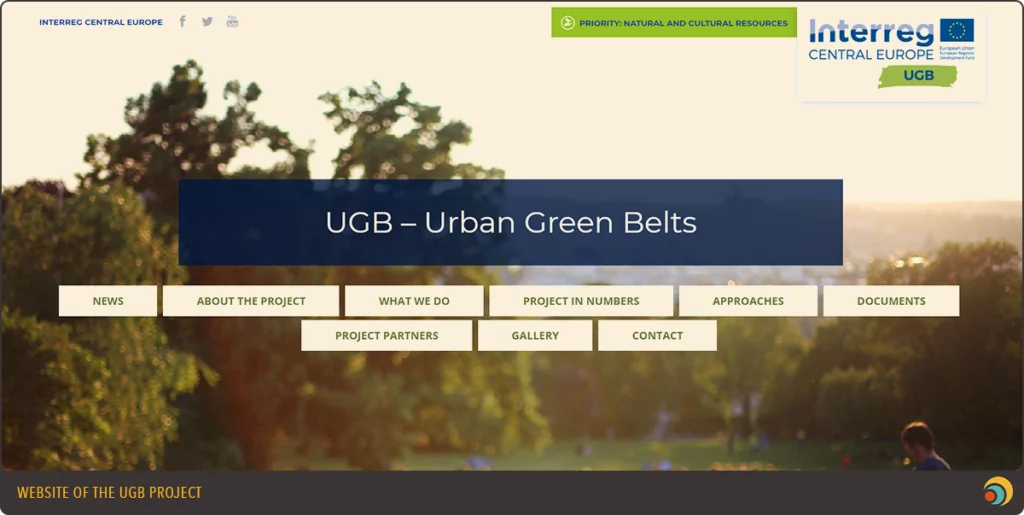… via Integrated Urban Green Space management
Today’s cities are heavily populated and densely built-up. Improving the quality of life of citizens by providing them with green spaces is therefore really challenging for municipalities that anyway have limited resources. So we give it a go and explore smart governance approaches addressing this challenge, through the example of the ‘Urban Green Belts’ project.
In the past couple of years, a Europe-wide consensus has emerged on the necessity of increasing the area of urban green spaces for the benefit of local citizens. This consensus, however, lacks the answer to shared responsibility: which actors should be in charge of planning, creating and maintaining these urban green spaces? Urban Green Belts (UGB), a Central Europe Interreg project took on the mission to find these answers by exploring three aspects in particular: ICT solutions, community involvement and smart governance practices.

The dilemma in question as for UGB is the following: according to the citizens, handling urban green spaces is de facto a municipality task; municipalities claim to lack the resources to take on this responsibility on their own. However, the mission is a joint one; so the solution can be to look for innovative ways to share this responsibility by exploring possibilities around the three aspects mentioned as focus points of UGB.
This is the time to reveal the most important finding that the UGB project concluded along the way: Smart governance only works hand in hand with an active community involvement, supported by ICT tools. Community involvement rocked UGB for all partners – complemented with other tools, the empowerment of residents in urban green space management brought the most added value. Let’s discover the concrete examples that worked!

The Stewardship Program was launched as a pilot by the Lead Partner: The 12th district of Budapest is the greenest district of the capital city of Hungary. Budapest’s biggest forests are situated in the district, making it the most popular place for sports and leisure not only for the locals but for everyone around. However, there are lots of informal public green spaces as well, like unmanaged green squares, single trees between buildings, street greenery, etc. – UGB concentrated on these, with the goal of involving residents into their maintenance. The Program allows citizens to ’adopt’ a public green space, sign a contract with the Municipality and then cooperate with the municipal Green Office to jointly take care of it. The initiative was backed up by a thorough ICT mapping of green spaces, making it easier to spot the best-suited areas for both parties; but the main conclusion was that cooperation goes smoothly if residents are given maximum freedom and responsibility. To be tested in your district as well! IUGB ended one year ago in May 2019, but Stewardship Program has been running ever since, making this tiny part of Budapest greener and nicer. Moreover, the Municipality carried on with this topic via a newly launched URBACT project Health&Greenspace; exploring how the health and wellbeing of its citizens can best be stimulated via upgraded green infrastructure design with strong community involvement.
Another pilot tackling community involvement was carried out in Maribor, Slovenia where the challenge was to involve locals in the revitalisation of abandoned sites with low priority for investments. The regional development agency carried out a set of actions to foster consultative and self-mobilized participation. They reached the locals by carrying out surveys at social events, such as festivals and on-the-spot surveys, these gave the most results. A Community Consultative Assembly was created, where tasks were assigned and the action planning started. A conceptual design document was prepared and presented to stakeholders, the municipality has been implementing it to revitalize and maintain the pilot area. This pilot showed that tangible results and immediate action can sustain local involvement. More information to be found here.
Citizen mobilisation was in focus in Krakow, Poland as well: the Witkowice Green living lab project was carried out, aiming to revitalize and reintegrate the abandoned Witkowice forest to the city leisure areas. People were reached by a multigenerational and gamified approach: an art competition was launched in schools “My Witkowice Forest”, a picnic was held in the area with social activities, and also an educational walk was held in the area. During the picnic, people were asked about their ideas on the improvement of the area, which was followed by small infrastructural improvements such as outdoors furniture and a bridge. A new playground will be built, as a result of inhabitants’ votes through a participatory budgeting process. These results persuaded the Municipality that it was worth investing in the forest, decisions were made that the area of the forest would be increased from 15ha to 120ha in the upcoming 5 years.
More details on the above initiatives can be found in the ’Smart Governance Manual on Integrated Urban Green Space Management’ published on ISSUU.
This article was prepared in cooperation with Péter Szuppinger, environmental expert of BURSTGroup.
